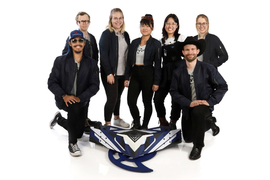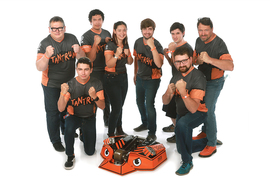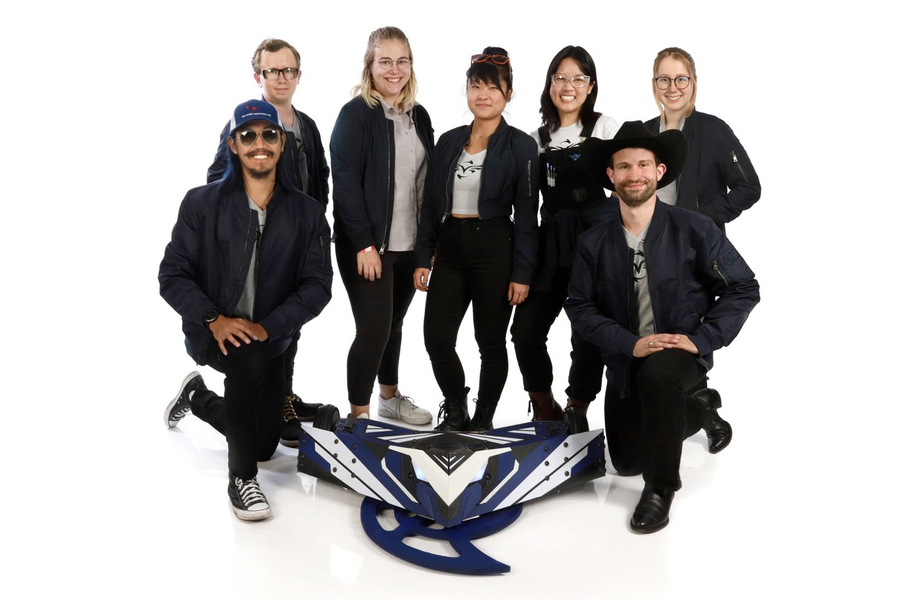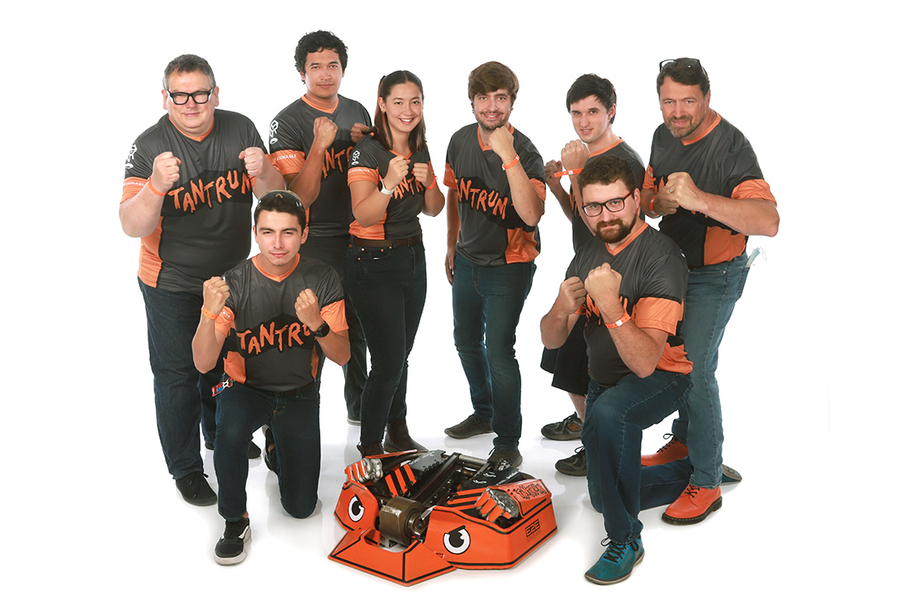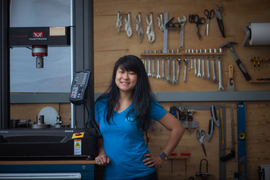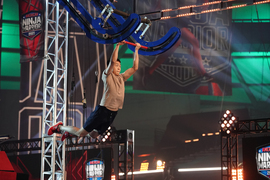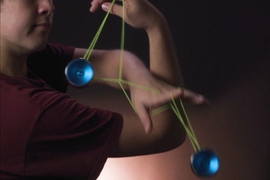First, there was music. Then lights began sweeping the smokey arena. The cage came alive with rotating steel blades and fire pits. The crowd grew hysterical in anticipation of the coming destruction.
Such was the scene of the momentous championship match in the last season of BattleBots, a popular, long-running show that pits 250-pound robots against each other for epic bouts of cataclysmic combat. In the match, MIT PhD student Ginger Schmidt became the first female captain (in this case, co-captain) to win the competition.
“It was crazy and pretty surreal,” says Schmidt, whose team, Seems Reasonable Robotics, built the winning bot, named Tantrum. “Our last fight was against a team we really respected. It was frightening. But we actually decapacitated them pretty early in the match, so at that point it was our match to lose and we just needed to be very strategic. There was a slow 60 seconds where we were like ‘Oh my god, did we just win?’”
Schmidt’s team’s victory was a much-celebrated first in the long-running Discovery channel show. MIT has played an outsized role in BattleBots since the show’s inception in 2000, and MIT students have registered a number of milestones on the program, which has seen involvement by women increase fivefold since 2016.
In this season, which is currently airing on Thursdays at 8 p.m., another team captain, MIT PhD candidate Lucy Du ’14, SM ’16, is the only woman serving as the controller of the robot during matches for her team, whose bot is named Valkyrie. As Du, Schmidt, and a slew of their MIT-affiliated companions compete against each other this season, they’re maintaining a supportive relationship.
“We have a really strong BattleBots community at MIT,” Schmidt says. “A lot of alumni still participate in the Boston area, and there’s a lot of shops around campus, so there’s a lot of collaborations and friendships. It’s at its core an engineering challenge, so of course MIT community members are going to get excited about that.”
Both Schmidt and Du hope their appearances on the highly visible show will help encourage girls and women to get involved in engineering. They also emphasize that they are part of a larger groundswell of change.
“I’m not the first woman to do BattleBots — there are women who have spent over a decade participating — so a lot of women before me paved the way,” Schmidt says. “I am definitely not the only woman doing great things in this sport.”
A turnaround story
When Schmidt first joined BattleBots with friends four years ago, it didn’t go well. The team’s robot got knocked out after losing two of its first three matches. Schmidt’s team redesigned the robot over the next year, spending countless hours trying to prevent the mishaps that derailed their first effort. Unfortunately, in the next season the robot didn’t fare much better.
But the team got another shot, and they did a little better in 2020, going 5-2. Then, a real turnaround finally came last year. With Schmidt serving as co-captain along with Alex Grant, the team went on one of the most dominant runs in BattleBots history, finishing the season 8-1.
“In our heads, we were just taking it one battle at a time,” Schmidt recalls. “When we were doing our interview before the final championship, the producer asked us how it felt to be there given that when we first came in we were essentially a joke bot.”
When Schmidt’s team prevailed in the championship match, she became the first female captain to hoist the Giant Nut that serves as the competition’s trophy (in addition to a $25,000 cash prize).
Schmidt, who is researching the use of optics to image heart disease as a PhD student in the Harvard-MIT Program in Health Sciences and Technology, says her BattleBots experience has aided her work at MIT.
“I think the patience, dedication, and grit required in BattleBots translates really well to my research,” Schmidt says. “If something is broken or not working, I can communicate what problems I’m having, and work through them and not give up.”
Du, who has been competing since the show rebooted seven seasons ago, has also made steady progress each season. (Her former team, SawBlaze, made the semifinals in 2021.) When members of her team split up after last season, Du became captain and leveraged the network she has built through many years of mentoring in MIT’s makerspaces. She recruited MIT alumnus John Mayo SM ’16 along with current MIT graduate student Natha “Bam” Singhasaneh. MIT graduate student Alexander Crease was already on the team.
“I think being a captain boils down to being able to make decisions all the time, small and large,” says Du, who is designing a prosthetic ankle that adjusts for people of different heights as part of her PhD in the Biomechatronics Group at the Media Lab. “You have to constantly make decisions in conditions of uncertainty, where you don’t feel like you know enough to make it, but it comes down to you anyway.”
Du’s decision to control the team’s robot during battle marks one of the few times a woman has taken the spot in front of the bulletproof glass that shields the controllers’ station from the mayhem in the ring.
“It’s significantly scarier to do, but it’s pretty exciting because they film it with a live audience,” Du says. “They play a lot of loud sounds and music to hype up the audience and it hypes you up, but I try to stay as calm as I can and remember what the plan is. Once the fight starts, it ends up being a blur. You kind of forget what’s happening because you’re so caught up in the moment.”
MIT has been well-represented in BattleBots every year of the show, something participants attribute to the thriving maker culture on campus. Another popular contestant among fans is Jamison Go SM ’15. Go and Du were part of the same team after the two met while mentoring in one of MIT’s makerspaces, before Du went on to captain Team Valkyrie.
That MIT-loaded team, SawBlaze, included João Ramos PhD ’18, John Mayo SM ’16, Christopher Merian SM ’16, Raymond Ma ’10, Shakti Shaligram SM ’19, Kimberly Jung SM ’20, Patrick McKeen SM '19, John Romanishin ’11, SM ’18, Alexander Hattori ’19, SM ’20, and Mason Massie ’20.
“BattleBots aligns with MIT because you’re building something with the intention of testing it to its very limit,” Schmidt says. “You’re building something and you’re not always confident it’s going to work, but that challenge is very exciting to us at MIT.”
A vehicle for progress
In addition to the battles, Du’s team also participates in outreach events to get kids interested in STEM, including a recent event at Boston Children’s Museum. Schmidt’s team, which is spread across the country but primarily based in California, hosted a party at a San Jose tech museum last season. When the championship episode aired, they rented out an iMax theater and filled it with local elementary school children along with friends and family.
“A lot of the people who do BattleBots are into promoting science and engineering,” Schmidt says. “It’s a really cool part of the show.”
Schmidt says women have been getting farther each year of the competition. The team Schmidt faced in the finals last season also had a female co-captain.
“I grew up doing high school robotics and none of my mentors looked like me, and they were still very supportive, but I think I always sought a mentor that I could relate to more, and so that’s always been a mission of mine, to perhaps repay the favor in my own way,” she says.
After the victory, Schmidt received messages on social media from fans who have young daughters that were excited about the win. Du has heard similar sentiments.
“One of the things we hear a lot from people is they say their daughter saw BattleBots and is now really interested in being an engineer, whereas before they didn’t think of it as an option,” Du says. “I think it’s just important to be able to see people that look like you in a position you want to be in in the future.”
